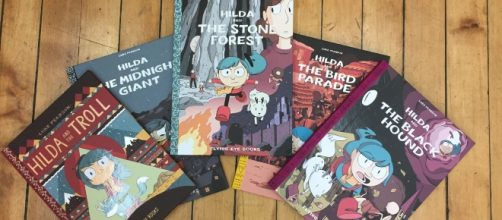Trolls, giant crows, flying fireballs and creatures comprised of wood are just a few of the zany and wonderfully imaginative features with the "Hilda" book series by author and illustrator Luke Pearson. The stories chronicle the adventures of a courageous blue-haired girl who resides in a land filled with mythical creatures and magical happenings.
From their start as a beautifully rendered comic series published by Flying Eye Books--the children's division of Nobrow Press--"Hilda" has secured a spot on Netflix as an animated series scheduled to debut in 2018.
Background
There are presently five books in the Hilda series with a sixth one in the works. The title character lives with her loving mother and loyal pet white fox, Twig, in the surreal land of Trolberg which is rifewith strange landscapes and odd creatures. “Hilda and the Troll” was the first story in the series followed by “Hilda and the Midnight Giant” and “Hilda and the Bird Parade.”
Then came “Hilda and the Black Hound” and, most recently, “Hilda and the Stone Forest” which gave Hilda's mother a chance to play a key role in the plot. Every story is gorgeously illustrated and told with humor, compassion and a deep-seeded sense of adventure.
Although perfectly appropriate for kids, the multilayered plots, dialogue, and emotional situations make this series appealing to teens and adults as well.
Recently, Luke Pearson spoke about his experiences creating this amazingly oddball series.
Interview
Blasting News (BN): When did you start drawing/writing Hilda?
Luke Pearson (LP): I first drew Hilda in my sketchbook in 2008. At first, I was just trying to draw someone I saw who was wearing a cool hat. She was a recurring character in my doodles and her design evolved.
The world she lives in was inspired by Scandinavian folk tales and the Nordic landscape as well as other fantasy worlds I'm fond of. I did a drawing of the character in front of a town I wanted to set stories in and they fit quite well. I drew the first Hilda story in 2010.
BN: How do you create these stories? For instance, do you think of plots or visuals first?
LP: It's a mixture of both; most of the time it starts with a vague visual. A particular creature or setting and then I try to find a good story that would incorporate that. Then I'll try and nail down a plot structure. I'll probably get some imagery in my head as I go along, or specific scenes I really want to see. Usually, I'll just bear them in mind as I re-read and write and see if there's somewhere they'll make sense. Or if I feel strongly about them I'll jam them in regardless then rework everything else around them. Basically, I'll keep doing that until it feels like the story I want to tell. It's a very messy process.
BN: Hilda's mom is becoming an increasingly popular character. Might Hilda's dad eventually play a role in her adventures?
LP: There are too many stories about absent/crappy fathers turning a new leaf and showing everyone that they were always a good guy really. It's not something I'm interested in getting into. Hilda's dad's never been there for her, and his absence doesn't define her or her mum in any way, so I don't see him as an important character. I may touch on what his deal is eventually, but he's not going to get to swoop in and take up a lot of panel space.
BN: Congratulations about getting the series on Netflix soon! How did that come about?
LP: It was the end result of lots of people being interested and various negotiations I wasn't entirely privy too. I'm working very closely with the people making it; there will be 13 half-hour episodes, and they're a mixture of stories from the books and new adventures.
BN: What advice would you give to aspiring illustrators and authors?
LP: Never be ashamed or embarrassed about your work. Do what you want to do and make it as good as you can.

